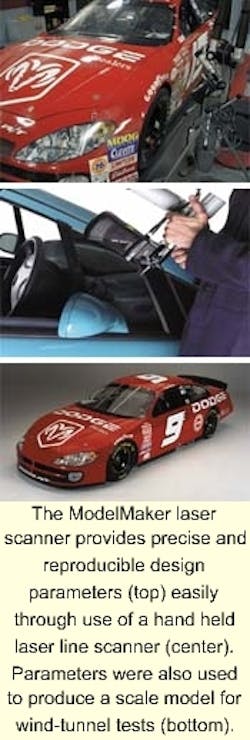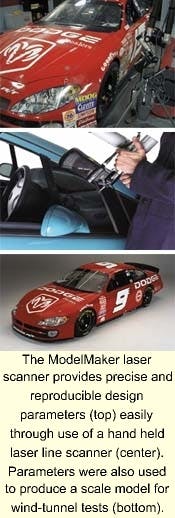Laser scanner helps design faster cars
Tim Malinovsky
A laser scanner is helping Evernham Motorsports (Charlotte, NC) create a new line of faster race cars by allowing the team to document even the smallest changes to the body design (see figure, top). In automobile racing, where as little as a 1/100 of a second difference in lap speed can mean the difference between first and second place, slight variations in body design have a huge impact on performance. Teams work hard to optimize the car's shape for the best aerodynamics, but until recently there was no way to precisely document that shape or of duplicating it exactlyif the car crashed, for instance, or in other cars in the team's line-up.
Dodge has hired Evernham to develop a Dodge Intrepid race car that will make its debut at the 2001 Daytona 500. Turning the production model of the Dodge Intrepid into a winning race car involves certain basic body changes such as converting from four doors to two and bringing the body lower to the ground. Beyond that, the task involves finding every performance advantage possible while working within National Association of Stock-Car Auto Racing (NASCAR) regulations.
Regulated design tolerance
According to NASCAR rules, all vehicles have many of the same components including transmission, steering gear, suspension, electrical system, fuel system, and brakes. The chassis are also basically the same, a front-steer-type chassis built by one of the three dominant chassis builders: Laughlin (Simpsonville, SC), Hopkins (Greenville, SC), or Hutcherson-Pagan (Charlotte, NC). The car bodies are tightly regulated by NASCAR. The acceptable shape is outlined by templates, 2-D silhouettes defining certain longitudinal or lateral cross sections of the body. The templates include acceptable tolerances, which can be as much as 0.5 in. or as little as 0.070 in.
Although the tolerances have been tightened up in recent years, there is still quite a bit of latitude that allows for some very different body shapes that still fit within the scope of NASCAR rules. As teams have become more knowledgeable about vehicle aerodynamics, for example, they have begun using the tolerances within the body templates to their advantage, fine-tuning the car's exterior to minimize wind resistance as much as possible. Since the changes they can make are very minor, documenting them with a great deal of precision is a necessity.
An additional reason Evernham Motorsports needs to document the body shape with a high level of accuracy is that the car Evernham designs will be a model for many other vehicles. It will be used by 10 different NASCAR teams, with each team building between 9 and 15 copies of the vehicle over the course of a racing season. Even though bodies are built according to templates, each one is slightly different, and even minor differences can have a major impact on the track. So when a body design performs well in the wind tunnel, the teams want to document it exactly and reproduce it consistently.
Manual methods of defining a car's shape use a tape measure, a piece of string, and a plumb bob. Technicians record measurements that indicate the critical parameters of the body but aren't able to capture the intricacies of a complex 3-D shape. A mechanical digitizer offers a slightly better option for capturing a 3-D shape. With this device, a technician physically touches the car body to record the x, y, z coordinate location of each point.
Point and shoot
With a laser scanner, however, it isn't necessary to physically touch the car, and it quickly captures enough coordinates to precisely define any 3-D shape. The major components of the ModelMaker (Nvision; Dallas, TX) system they use are a 3-D laser sensor, a mechanical digitizer on which the sensor is attached, a PC, and software that extracts, displays, and manipulates the data.1
After the team built a prototype of the new Dodge Intrepid, the shape was traced by simply holding the single viewpoint laser stripe sensor so that a line of laser light appeared on the body (see figure, center). Laser stripe sensors, which are significantly faster than simple laser point sensors, projected a line of laser light onto the vehicle while a small CCD camera viewed the line as it appeared on the surface. The mechanical digitizer moved freely about the body, capturing data rapidly and with a high degree of resolution, while a dedicated interface card translated the video image of the line into 3-D coordinates. The data was combined with the Cartesian and angular coordinates generated at each position of the mechanical arm resulting in a dense cloud of 3-D data describing the surface of the object. A laser scan of an entire car body usually generates 25 million 3-D coordinates and can be done in 12 to 14 hours.
Once the team had the coordinate data, it was used in several ways. One way was for the production of a scale model for aerodynamic testing. Evernham Motorsports sent the scan data to Dodge, which also uses a similar system in its development efforts. Dodge imported the data into its CAD system, Catia, scaled it down and used it to produce a 3/8 clay and fiberglass scale model that was then tested in a wind tunnel (see figure, bottom).
The scan data was also used as a precise record for tracking aerodynamic improvements. The original scan served as a record of the baseline shape. Then, as the prototype body was modified to improve aerodynamics, the scanner was used again to quantify these relatively minor adjustments to an extent that was never possible in the past. Then once the team had a shape that performs well, they had it laser scanned so there is a permanent and precise record of it. That ensures the lessons learned about improving aerodynamic performance, no matter how minor, are reapplied to future cars.
The third way the team uses the scan data is as a complement to the templates used to build the cars, such that designers can look up any value they need, such as the height of the hood where it meets the windshield. The scan data can also be used to produce additional cross sections if a team feels it is missing some information in the existing templates. Finally, the scan data serves as a way of validating the Dodge Intrepid bodies built by the race teams. As the teams build vehicles throughout the race season, they will want to replicate Evernham's design exactly. They can verify their work by comparing a new car's shape with the digital record available from Evernham.
REFERENCE
- NVision Inc., 11455 Newkirk St. Ste #1404, Dallas, Texas 75229; www.nvision3d.com.
TIM MALINOVSKY is an engineer at Evernham Motorsports NASCAR, Charlotte, NC; e-mail: [email protected].

